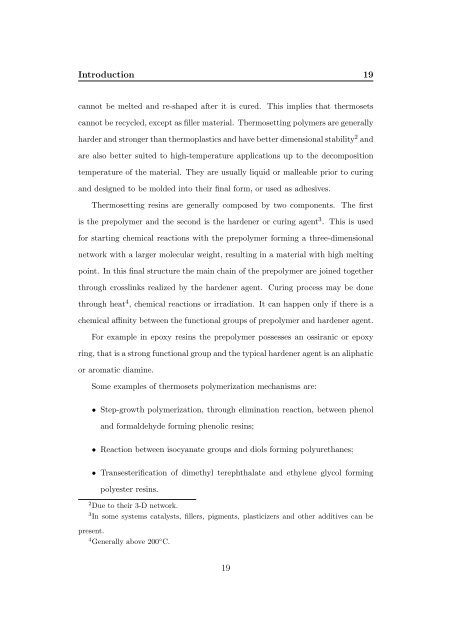Kinetic Analysis and Characterization of Epoxy Resins ... - FedOA
Kinetic Analysis and Characterization of Epoxy Resins ... - FedOA
Kinetic Analysis and Characterization of Epoxy Resins ... - FedOA
Create successful ePaper yourself
Turn your PDF publications into a flip-book with our unique Google optimized e-Paper software.
Introduction 19<br />
cannot be melted <strong>and</strong> re-shaped after it is cured. This implies that thermosets<br />
cannot be recycled, except as filler material. Thermosetting polymers are generally<br />
harder <strong>and</strong> stronger than thermoplastics <strong>and</strong> have better dimensional stability 2 <strong>and</strong><br />
are also better suited to high-temperature applications up to the decomposition<br />
temperature <strong>of</strong> the material. They are usually liquid or malleable prior to curing<br />
<strong>and</strong> designed to be molded into their final form, or used as adhesives.<br />
Thermosetting resins are generally composed by two components. The first<br />
is the prepolymer <strong>and</strong> the second is the hardener or curing agent 3 . This is used<br />
for starting chemical reactions with the prepolymer forming a three-dimensional<br />
network with a larger molecular weight, resulting in a material with high melting<br />
point. In this final structure the main chain <strong>of</strong> the prepolymer are joined together<br />
through crosslinks realized by the hardener agent. Curing process may be done<br />
through heat 4 , chemical reactions or irradiation. It can happen only if there is a<br />
chemical affinity between the functional groups <strong>of</strong> prepolymer <strong>and</strong> hardener agent.<br />
For example in epoxy resins the prepolymer possesses an ossiranic or epoxy<br />
ring, that is a strong functional group <strong>and</strong> the typical hardener agent is an aliphatic<br />
or aromatic diamine.<br />
Some examples <strong>of</strong> thermosets polymerization mechanisms are:<br />
• Step-growth polymerization, through elimination reaction, between phenol<br />
<strong>and</strong> formaldehyde forming phenolic resins;<br />
• Reaction between isocyanate groups <strong>and</strong> diols forming polyurethanes;<br />
• Transesterification <strong>of</strong> dimethyl terephthalate <strong>and</strong> ethylene glycol forming<br />
polyester resins.<br />
2 Due to their 3-D network.<br />
3 In some systems catalysts, fillers, pigments, plasticizers <strong>and</strong> other additives can be<br />
present.<br />
4 Generally above 200 ◦ C.<br />
19
















